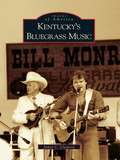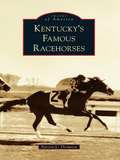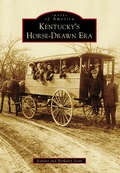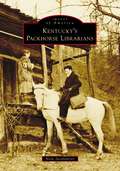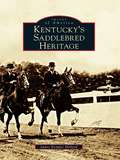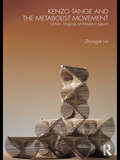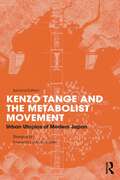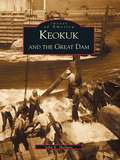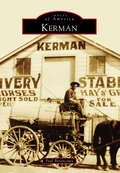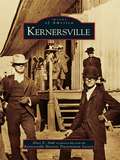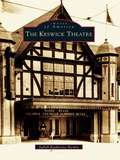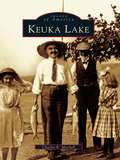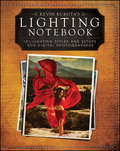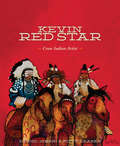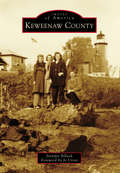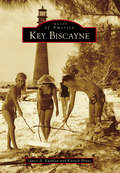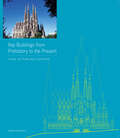- Table View
- List View
Kentucky's Bluegrass Music
by James C. ClaypoolIt is likely that most fans of bluegrass music would concede that no state should be more associated with bluegrass music than Kentucky--and rightly so. Bluegrass music draws its name from the band that Kentuckian Bill Monroe formed during the late 1930s and 1940s. Bill named his band Bill Monroe and The Blue Grass Boys to honor his home state. Eventually, the music these bands and others like them were playing came to be known as bluegrass music. Later, another Kentuckian, Ebo Walker, while playing with the Bowling Green-based bluegrass band, New Grass Revival, coined the phrase "newgrass" to describe the band's progressive style of music. Other Kentuckians such as Bobby and Sonny Osborne, J. D. Crowe, Ricky Skaggs, and Dale Ann Bradley have become bluegrass stars. Some of the musicians from Kentucky covered in this book are quite famous--some are not. Famous or not, all of them have a deep-rooted passion for the music they play.
Kentucky's Famous Racehorses
by Patricia L. ThompsonCentral Kentucky is home to many magnificent horses and their farms. Although there are numerous places to witness these beautiful animals, including Keeneland, Churchill Downs, Pimlico, and Belmont, their history often gets overwhelmed by their statistics. Images of America: Kentucky's Famous Racehorses goes beyond the numbers and provides insight into the character of these beloved creatures by featuring stories straight from those closest to the horses--the grooms.
Kentucky's Horse-Drawn Era
by Jeanine Scott Berkeley ScottImages of America: Kentucky's Horse-Drawn Era takes a look at the days when animals--mostly horses and mules--supplied the "horsepower" for daily life in Kentucky. The animals' work included hauling buggies, carriages, wagons, hearses, circus wagons, parade floats, bookmobiles, coal cars, school buses, and everything and everyone in between. This book even has a photograph of a mule team pulling a two-story house down the street of a small town in Kentucky; other unusual images feature a "high-diving" horse and the winners of the Mule Derby. These vintage photographs highlight horses and mules in some of the many roles they filled before the advent of the automobile, the pickup truck, and the tractor.
Kentucky's Packhorse Librarians (Images of America)
by Nicki JacobsmeyerMarking the ridgelines and hearts of the Appalachians during the Great Depression, packhorse librarians delivered hope, one book at a time.When the Great Depression started, folks stumbled on hard times. Many lost their jobs and homes, and they struggled to support their families. But people craved hope for the future, and hope arrived with the packhorse librarians through Pres. Franklin D. Roosevelt’s New Deal in 1933. Each week, children, families, and schoolhouses celebrated when their packhorse librarian arrived at their doors with books. After being handled by many cherished hands, reading materials needed to be taken out of circulation. The librarians constructed scrapbooks and filled them with beloved items—recipes, quilt patterns, pictures, and stories. Challenges awaited the librarians at every pass. From muddy creeks to snowy hillsides, the packhorse librarians delivered books and hope to their patrons. Although the program ended in 1943, the lasting effects on literacy and the communities these packhorse librarians visited can still be seen today.Author Nicki Jacobsmeyer lives in rural Missouri, where she writes fiction and nonfiction for adults and children. She inspires others to discover and dream through reading and believes books are windows to the world.
Kentucky's Saddlebred Heritage (Images of America)
by James Kemper MillardLong associated with fine Thoroughbred horses, Kentucky's Bluegrass region is also home to America's oldest indigenous breed: the American Saddlebred horse. A composite of several breeds, the Saddlebred was developed by 18thcentury colonists who sought a goodlooking, sensible, adaptable, and comfortable animal to ride and drive. These traits made it the mainstay of the Confederate cavalry during the Civil War and the choice mount of many generals on both sides. As the Industrial Revolution replaced the need for working horse power, the Saddlebred evolved naturally into recreational activities. Affectionately known as "peacock of the show ring," the Saddlebred's beauty, expression, and athleticism epitomize the essence of a show horse. In many ways, the breed's history parallels that of America and unfolds in pictures in Kentucky's Saddlebred Heritage.
Kenya's Art
by Linda TriceRecycle! Reuse! Make Art!Kenya&’s class is on spring vacation and their teacher asked them to write a report about how they spent their time. But vacation is almost over and Kenya hasn't done anything worth noting. A late visit to a museum's recycling exhibit and a walk through her neighborhood with her daddy inspire Kenya to use her old, broken toys and other items to make art with her family. Now she's prepared to teach her whole class how to Recycle! Reuse! Make Art!This warm and engaging companion to Kenya's Song depicts the enthusiasm and creativity of one young girl in a diverse community who engages wholeheartedly with her friends, her environment, and herself.
Kenya: A View Through My Lens
by Hamid Obaid Al AliDive into the heart of Africa’s majestic landscapes and encounter the untamed beauty of Kenya’s wildlife through the lens of Hamid’s captivating photography. From the sweeping savannahs of the Maasai Mara to Amboseli National Park, this stunning collection transports you to the vibrant world of Kenya’s diverse ecosystems. Get up close and personal with iconic species such as elephants, lions, giraffes, and rhinos, as well as lesser-known treasures like the gray-crowned crane and the African fish eagle. With each breathtaking image, immerse yourself in the raw power, grace, and intricate beauty of Kenya’s natural wonders. A visual masterpiece that celebrates the spirit of the African wilderness, this book is a must-have for wildlife enthusiasts, photography aficionados, and armchair travelers alike. Prepare to be spellbound by the splendor of Kenya’s wildlife in this unforgettable journey through the lens.
Kenyan, Christian, Queer: Religion, LGBT Activism, and Arts of Resistance in Africa (Africana Religions #3)
by Adriaan van KlinkenPopular narratives cite religion as the driving force behind homophobia in Africa, portraying Christianity and LGBT expression as incompatible. Without denying Christianity’s contribution to the stigma, discrimination, and exclusion of same-sex-attracted and gender-variant people on the continent, Adriaan van Klinken presents an alternative narrative, foregrounding the ways in which religion also appears as a critical site of LGBT activism.Taking up the notion of "arts of resistance," Kenyan, Christian, Queer presents four case studies of grassroots LGBT activism through artistic and creative expressions—including the literary and cultural work of Binyavanga Wainaina, the "Same Love" music video produced by gay gospel musician George Barasa, the Stories of Our Lives anthology project, and the LGBT-affirming Cosmopolitan Affirming Church. Through these case studies, Van Klinken demonstrates how Kenyan traditions, black African identities, and Christian beliefs and practices are being navigated, appropriated, and transformed in order to allow for queer Kenyan Christian imaginations.Transdisciplinary in scope and poignantly intimate in tone, Kenyan, Christian, Queer opens up critical avenues for rethinking the nature and future of the relationship between Christianity and queer activism in Kenya and elsewhere in Africa.
Kenyan, Christian, Queer: Religion, LGBT Activism, and Arts of Resistance in Africa (Africana Religions #3)
by Adriaan van KlinkenPopular narratives cite religion as the driving force behind homophobia in Africa, portraying Christianity and LGBT expression as incompatible. Without denying Christianity’s contribution to the stigma, discrimination, and exclusion of same-sex-attracted and gender-variant people on the continent, Adriaan van Klinken presents an alternative narrative, foregrounding the ways in which religion also appears as a critical site of LGBT activism.Taking up the notion of “arts of resistance,” Kenyan, Christian, Queer presents four case studies of grassroots LGBT activism through artistic and creative expressions—including the literary and cultural work of Binyavanga Wainaina, the “Same Love” music video produced by gay gospel musician George Barasa, the Stories of Our Lives anthology project, and the LGBT-affirming Cosmopolitan Affirming Church. Through these case studies, Van Klinken demonstrates how Kenyan traditions, black African identities, and Christian beliefs and practices are being navigated, appropriated, and transformed in order to allow for queer Kenyan Christian imaginations.Transdisciplinary in scope and poignantly intimate in tone, Kenyan, Christian, Queer opens up critical avenues for rethinking the nature and future of the relationship between Christianity and queer activism in Kenya and elsewhere in Africa.
Kenzie's Rules for Life: How to Be Happy, Healthy, and Dance to Your Own Beat
by Maddie Ziegler Mackenzie ZieglerAn inspirational, upbeat collection of relatable lessons from the teen sensation, Mackenzie Ziegler—an award-winning dancer, singer/songwriter, and actress.Growing up is hard, but growing up in the spotlight is even harder. However, Mackenzie Ziegler is taking it all in stride, thanks to her positive attitude on life. From getting her start on Dance Moms, to her sold-out tour alongside Johnny Orlando, there’s nothing that she can’t do. In Kenzie’s Rules for Life, the dance prodigy, singer/songwriter, actress, and model offers her advice on friendship, family, fitness, style, and positivity. She shares lessons drawn from her own experiences for those navigating through their tween years on how to be happy, healthy, and confident in all aspects of their lives.
Kenzo Tange and the Metabolist Movement: Urban Utopias of Modern Japan
by Zhongjie LinMetabolism, the Japanese architectural avant-garde movement of the 1960s, profoundly influenced contemporary architecture and urbanism. This book focuses on the Metabolists’ utopian concept of the city and investigates the design and political implications of their visionary planning in the postwar society. At the root of the group’s urban utopias was a particular biotechical notion of the city as an organic process. It stood in opposition to the Modernist view of city design and led to such radical design concepts as marine civilization and artificial terrains, which embodied the metabolists’ ideals of social change. Tracing the evolution of Metabolism from its inception at the 1960 World Design Conference to its spectacular swansong at the Osaka World Exposition in 1970, this book situates Metabolism in the context of Japan’s mass urban reconstruction, economic miracle, and socio-political reorientation. This new study will interest architectural and urban historians, architects and all those interested in avant-garde design and Japanese architecture.
Kenzo Tange and the Metabolist Movement: Urban Utopias of Modern Japan
by Zhongjie LinAmid Japan’s political turbulence in 1960, seven architects and designers founded Metabolism to propagate radical ideas of urbanism. Kenzō Tange’s Plan for Tokyo 1960 further celebrated urban expansion as organic processes and pushed city design to an unprecedented scale. Metabolists’ visionary schemes of the city gave birth to revolutionary design paradigms, which reinvented the discourse of modern Japanese architecture and propelled it through the years of Economic Miracle to a global prominence. Their utopian concepts, which often envisaged the sea and the sky as human habitats of the future, reflected fundamental issues of cultural transformation and addressed environmental crises of the postindustrial society. This new edition expands Zhongjie Lin’s pathbreaking account on Tange and Metabolism centered at the intersection of urbanism and utopianism. The thorough historical survey, from Metabolism’s inauguration at the 1960 World Design Conference to the apex of the movement at Expo ’70 and further to the recent demolition of Nakagin Capsule Tower, leads to a definition of three Metabolist urban paradigms – megastructure, group form, and ruins – which continue to inspire experiments in architecture, city design, and conservation. Kenzō Tange and the Metabolist Movement is a key book for architectural and urban historians, architects, and all those interested in avant-garde design, Japanese architecture, and contemporary urbanism.
Keokuk and the Great Dam
by John E. HallwasThis remarkable pictorial history tells the story of an engineering marvel: the first dam built across theMississippi River (from 1910-1913), and the historicMidwestern community that fostered the world-famoushydroelectric project. Keokuk and the Great Dam is the story of a colorful and historic river town with a dream of economic development and cultural progress; a self-taught engineer who took on a challenge that no one else wanted to attempt; and a massive construction effort that pitted men and machines against the awesome power of America's greatest river. Completed shortly before WWI, the Keokuk dam (now known as Lock and Dam No. 19) was the culmination of a long struggle to employ the Mississippi River for hydroelectric power and to improve navigation on the great waterway. In frontier days the Des Moines Rapids, stretching north from Keokuk, prevented loaded steamboats from moving upriver. They also created a business opportunity for local residents. A rapidly growing town by the 1850s, Keokuk went into decline for many years when it failed to secure adequate railroad connections. But the coming of hydroelectric powerfostered a new dream, and local leaders set out to harness the great river. What followed was a dramatic effort that drew international attention, produced the world's second largest dam (at the time), and forever changed both the community and the fabled American waterway.
Kerman (Images of America)
by Paul BetancourtKerman sits in the heart of California's great San Joaquin Valley. First established in 1891 as a train stop for the Southern Pacific Railroad, the town site was originally named Collis Station for the railroad's president, Collis P. Huntington. Even in its earliest days, agriculture was the driving force behind Kerman's economy. Advances in irrigation as well as Kerman's close proximity to two of the region's largest rivers--Kings and San Joaquin--resulted in abundant access to water, attracting farmers and land investors at the start of the 20th century. As the community grew, alfalfa hay, raisins, and dairy products became mainstays in Kerman's agricultural production. By 1910, Kerman had a volunteer fire department, a library, and new businesses. Images of America: Kerman explores the first 80 years of a town that continues to grow and diversify.
Kernel Learning Algorithms for Face Recognition
by Jeng-Shyang Pan Jun-Bao Li Shu-Chuan ChuKernel Learning Algorithms for Face Recognition covers the framework of kernel based face recognition. This book discusses the advanced kernel learning algorithms and its application on face recognition. This book also focuses on the theoretical deviation, the system framework and experiments involving kernel based face recognition. Included within are algorithms of kernel based face recognition, and also the feasibility of the kernel based face recognition method. This book provides researchers in pattern recognition and machine learning area with advanced face recognition methods and its newest applications.
Kernersville (Images of America)
by Kernersville Historic Preservation Society Alice E. SinkNative Americans first inhabited the eastern Forsyth County area, a natural watershed and source of six rivers and creeks. About 1756, Irishman Caleb Story settled here on 400 acres of wooded land. Years later, Story sold his land to David Morrow for a purported four gallons of rum. About 1771, William Dobson purchased the original acreage and additional tracts and built an inn near what is now Mountain Street and Main Street. He named this junction Dobson'sCrossroads. On June 2, 1791, President George Washington ate breakfast at Dobson's Tavern. On November 14, 1817, German-born Joseph Kerner (also spelled K¶rner) purchased the land and renamed the area Kerner's Crossroads. This begins the story of Kernersville. The same roads, still graced with historic churches, stores, and homes, crisscross at the heart of this community. K¶rner's Folly, which contains 22 rooms, housed the first private little theater in America.
Keswick Theatre, The (Images of America)
by Judith Katherine HerbstThe Keswick Theatre, located just outside Philadelphia, opened in 1928 in an era when four thousand similar structures were in various stages of design and construction across the country. Vaudeville was in its final days and film was just being born. Designed by acclaimed architect Horace Trumbauer, the theater evolved into the area's premier movie house. When the theater was threatened with demolition in the early 1980s, the Glenside Landmarks Society was formed with the hopes of restoring the building to its former grandeur. Today, operating as a commercial venture, it is one of the most acclaimed concert halls in the Philadelphia area. The Keswick Theatre celebrates this historic landmark through vintage images and recognizes the dedicated community members who have kept its doors open.
Keuka Lake
by Charles R. MitchellNestled among the hills of western New York State is the beautiful lake Keuka, the Indian word for "canoe landing." Once visited, the loveliness and serenity of this particular lake in New York's Finger Lakes region draws people back. Visitors return to stay for a week or the summer, and tourists come back, often annually. Many who have lived or summered at the lake return to retire. Keuka Lake brings back the time period from 1850 to 1960, the era of black-and-white photography. Featured are the local grapes and wineries, the steamboats, the commercial activities on and around the lake, and the lake itself. Today, the boats are no longer steam powered and the wineries are more plentiful, but other aspects of life have not changed. The residents are hospitable; the pace is slow; the lake is resplendent and inviting.
Kevin Kubotas Lighting Notebook
by Kevin KubotaGet professional advice from one of the world's top wedding photographersCreative use of lighting is a hallmark of quality photography. Kevin Kubota has been listed among the world's top 10 wedding photographers by American Photo magazine and named a Legend Behind the Lens by Nikon. This guide features dozens of his unique lighting and post-production recipes and techniques, each illustrated with a spectacular image.Author Kevin Kubota enjoys a cult-like following among professional photographers and has earned numerous accolades for his talentIncludes the author's unique lighting and post-production recipes and techniques that reinforce the theory that good lighting is the key to quality photographyPresents a number of shooting scenarios with behind-the-scenes setup, a description of the photographer's objective, the equipment used, and the resulting image for eachFeatures a companion app that will enable the photographer to search and find lighting suggestions by subject, style, budget, equipment, and other guidelines, all while in the fieldKevin Kubota's Lighting Notebook for Digital Photographers is almost like having the famous photographer sharing his secrets with you one on one.
Kevin Red Star: Crow Indian Artist
by Kitty Leaken Daniel GibsonThe life, work, and inspiration of the acclaimed Native American artist are explored in this beautifully illustrated book. Born and raised on the Crow reservation in southern Montana, Kevin Red Star celebrates the history and culture of the Crow Nation with his artwork. As a visual historian of his people, he explores traditional roots with a contemporary outlook, producing a body of work that is revered by galleries, museums, and collectors. Author Daniel Gibson and photographer Kitty Leaken showcase the talents of Red Star in this collection of artwork while also exploring his life and artistic development. Red Star&’s friends and family, his childhood on the reservation, and his time at the Institute of American Indian Arts and San Francisco Art Institute all feed into his iconoclastic and ever-evolving artwork.
Kew - Fragrance: From plant to perfume, the botanical origins of scent
by Royal Botanic Kew Josh Carter Samuel GearingFlowers, fruits, herbs, resins, woods, spices. From bloom to bottle, the subtle art of perfume has always had its roots in the natural world.Fragrance reveals the botanical backgrounds of 100 intoxicating ingredients that define scents from Chanel No5 to Opium. Evocative insights from experts at the Royal Botanic Gardens, Kew, and fragrance specialists Josh Carter and Samuel Gearing combine with beautiful botanical illustrations in this enchanting distillation of the origins of perfume.
Kew - Fragrance: From plant to perfume, the botanical origins of scent
by Royal Botanic Kew Josh Carter Samuel GearingFlowers, fruits, herbs, resins, woods, spices. From bloom to bottle, the subtle art of perfume has always had its roots in the natural world.Fragrance reveals the botanical backgrounds of 100 intoxicating ingredients that define scents from Chanel No5 to Opium. Evocative insights from experts at the Royal Botanic Gardens, Kew, and fragrance specialists Josh Carter and Samuel Gearing combine with beautiful botanical illustrations in this enchanting distillation of the origins of perfume.
Keweenaw County
by Jennifer Billock Jo UrionAlthough the largest Michigan county with land and water combined, Keweenaw County is also the most sparsely populated--at least during the vicious winters. The population blooms in the summertime when seasonal residents come in droves to enjoy their little slice of heaven. The county was formed in 1861 as an offshoot of Houghton County and now encompasses the top half of the Keweenaw Peninsula, where Michigan's Upper Peninsula juts north into Lake Superior. Throughout the 1800s, the area was at the center of the copper mining boom, spurring construction of Fort Wilkins in Copper Harbor. The military outpost served to keep order among miners and the area's native inhabitants, the Ojibwa. Moving through time, Keweenaw County would also serve as a hub for the maritime, fishing, and lumbering industries before becoming the resort community it is today.
Key Biscayne
by Kirsten N. Hines James A. KushlanKey Biscayne is an island paradise umbilically connected to Miami by a three-and-a-half-mile-long causeway. Its recorded history is one of the longest in North America, starting five centuries ago with Juan Ponce de León's arrival, the second official landing of Europeans in North America after Columbus. For centuries, Key Biscayne was an important landmark for Gulf Stream mariners, and the Cape Florida Lighthouse, built in 1825, is the oldest remaining structure in the region. The key was the site of an infamous Indian attack, a Second Seminole War military base, scientific expeditions, a Civil War raid, a tropical plantation, and finally a residential village and county, state, and national parks. When the key served as Richard Nixon's vacation White House, its worldwide fame grew. Key Biscayne now hosts a multinational community and hundreds of thousands of visitors annually.
Key Buildings from Prehistory to the Present: Plans, Sections And Elevations
by Andrew BallantyneThe latest in this successful series, this book features around 150 of the most important buildings in the history of world architecture – from the pyramids and Parthenon to some of the most significant works by recent architects. The buildings are organized by type – from places of worship and public buildings to houses – and are divided into nine chapters, each with an informative introduction that surveys the history of that type. For each building there are numerous, accurate scale drawings showing a combination of floor plans, elevations and sections as appropriate, all specially redrawn for this book. The quality and number of the line drawings, together with the authoritative text by a renowned architectural historian, allow all the buildings to be understood in detail and make this an invaluable resource for students.
